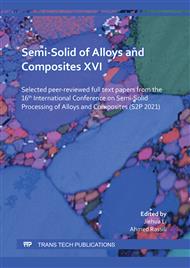[1]
Liao X N, Cao F H, Chen A N, Liu W J, Zhang J Q, Cao C N, In-situ investigation of atmospheric corrosion behavior of bronze under thin electrolyte layers using electrochemical technique, T. Nonferr. Metal. Soc.. 22(2012) 1239-1249.
DOI: 10.1016/s1003-6326(11)61311-3
Google Scholar
[2]
Kato H, Takama M, Iwai Y, Washida K, Sasaki Y. Wear and mechanical properties of sintered copper–tin composites containing graphite or molybdenum disulfide, Wear. 255(2003) 573-578.
DOI: 10.1016/s0043-1648(03)00072-3
Google Scholar
[3]
Deng X, Chawla N, Chawla K.K., Koopman M. Deformation behavior of (Cu, Ag)–Sn intermetallics by nanoindentation, Acta Mater.. 52(2004) 4291-4303.
DOI: 10.1016/j.actamat.2004.05.046
Google Scholar
[4]
Šatović D, Žulj L, Desnica V, Fazinić S, Martinez S. Corrosion evaluation and surface characterization of the corrosion product layer formed on Cu–6Sn bronze in aqueous Na2SO4 solution, Corros. Sci.. 51(2009) 1596-1603.
DOI: 10.1016/j.corsci.2009.04.002
Google Scholar
[5]
Kohler F, Campanella T, Nakanishi S, Rappaz M. Application of single pan thermal analysis to Cu–Sn peritectic alloys, Acta Mater.. 56(2008) 1519-1528.
DOI: 10.1016/j.actamat.2007.12.006
Google Scholar
[6]
Ünlü B.S., Atik E. Evaluation of effect of alloy elements in copper based CuSn10 and CuZn30 bearings on tribological and mechanical properties, J. Alloys Compd.. 489(2010) 262-268.
DOI: 10.1016/j.jallcom.2009.09.068
Google Scholar
[7]
Robbiola L, Tran T.T.M, Dubot P, Majerus O, Rahmouni K. Characterisation of anodic layers on Cu–10Sn bronze (RDE) in aerated NaCl solution, Corros. Sci.. 50(2008) 2205-2215.
DOI: 10.1016/j.corsci.2008.06.003
Google Scholar
[8]
Taşliçukur Z, Altuğ G.S., Polat S, Hakan A.Ş., Türedi E. A Microstructural Study on CuSn10 Bronze Produced By Sand And Investment Casting Techniques, Proceedings of XXI, International Conference on Metallurgy and Materials. (2012).
Google Scholar
[9]
Halvaee A, Talebi A. Effect of process variables on microstructure and segregation in centrifugal casting of C92200 alloy, J. Mater. Process. Tech.. 118(2001) 122-126.
DOI: 10.1016/s0924-0136(01)00904-9
Google Scholar
[10]
Poggio E, Piccardo P. Tint metallography of as-cast tin-bronzes for hot tearing investigation, Microscopy and Analysis. (2004) 5-8.
Google Scholar
[11]
Flemings M C. Behavior of metal alloys in the semisolid state, Metall. Trans.. 22(1991) 957-981.
DOI: 10.1007/bf02661090
Google Scholar
[12]
Lashkari O, Ghomashchi R. The implication of rheology in semi-solid metal processes: an overview, J. Mater. Process. Tech.. 182 (2007) 229-240.
DOI: 10.1016/j.jmatprotec.2006.08.003
Google Scholar
[13]
Ji S, Fan Z, Bevis M J. Semi-solid processing of engineering alloys by a twin-screw rheomoulding process, Mat. Sci. Eng. A. 299 (2001) 210-217.
DOI: 10.1016/s0921-5093(00)01373-3
Google Scholar
[14]
Wang Y F, Zhao S D, Zhang C Y. Microstructures and mechanical properties of semi-solid squeeze casting ZL104 connecting rod, T. Nonferr. Metal. Soc.. 28(2018) 235-243.
DOI: 10.1016/s1003-6326(18)64656-4
Google Scholar
[15]
Fan L L, Zhou M Y, Zhang Y W X, Tang Q, Quan G F, Liu B, The semi-solid microstructural evolution and coarsening kinetics of AZ80-0.2Y-0.15Ca magnesium alloy, Mater. Charact.. 154(2019) 116-126.
DOI: 10.1016/j.matchar.2019.05.019
Google Scholar
[16]
Kleiner S, Beffort O, Wahlen A, Uggowitzer P J. Microstructure and mechanical properties of squeeze cast and semi-solid cast Mg–Al alloys, J. Lig. Met. 2(2002) 277-280.
DOI: 10.1016/s1471-5317(03)00012-9
Google Scholar
[17]
Wang K, Zhang Z Q, Wen H, Xia D, Sun W J. Microstructural evolution of a fine-grained 7075Al alloy processed by friction stir process during partial remelting, Mater. Charact., 121(2016) 1-8.
DOI: 10.1016/j.matchar.2016.09.029
Google Scholar
[18]
Zhang Y, Wu G, Liu W, Zhang L, Pang S, Wang Y, Ding W. Effects of processing parameters and Ca content on microstructure and mechanical properties of squeeze casting AZ91–Ca alloys, Mat. Sci. Eng. A. 595(2014) 109-117.
DOI: 10.1016/j.msea.2013.12.014
Google Scholar
[19]
Jiang J, Xiao G, Wang Y, Qi Y. Microstructure evolution of wrought nickel based superalloy GH4037 in the semi-solid state,Mater. Charact.. 141(2018) 229-237.
DOI: 10.1016/j.matchar.2018.04.057
Google Scholar
[20]
Li Y K, Li L, Geng B Y, Wang Q P, Zhou R F, Wu Xing, Xiao Han. Microstructure characteristics and strengthening mechanism of semisolid CuSn10P1 alloys, Mater. Charact., 172(2021) 110898.
DOI: 10.1016/j.matchar.2021.110898
Google Scholar


